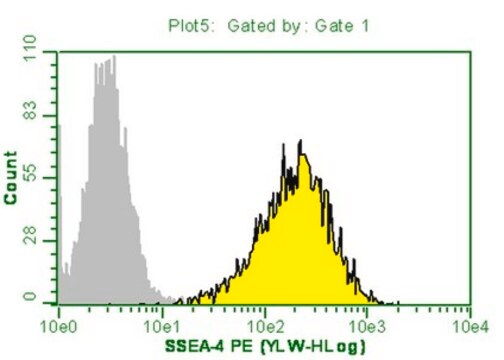FCMAB115F
Anti-TRA-1-60 Antibody, clone TRA-1-60, FITC conjugate
clone TRA-1-60, from mouse, FITC conjugate
About This Item
Produits recommandés
Source biologique
mouse
Niveau de qualité
Conjugué
FITC conjugate
Forme d'anticorps
purified antibody
Type de produit anticorps
primary antibodies
Clone
TRA-1-60, monoclonal
Réactivité de l'espèce (prédite par homologie)
human (based on 100% sequence homology)
Technique(s)
flow cytometry: suitable
immunocytochemistry: suitable
Isotype
IgM
Conditions d'expédition
wet ice
Modification post-traductionnelle de la cible
unmodified
Informations sur le gène
human ... PODXL(5420)
Description générale
Spécificité
No immunoreactivity is seen with murine EC, EG, or ES cells. Both the TRA-1-60 and TRA-1-81 monoclonal antibodies (MAB4381) recognize antigens that are associated with a pericellular matrix proteoglycan. TRA-1-60 reacts with a sialidase-sensitive epitope whilst TRA-1-81 reacts with an unknown epitope of the same molecule
Immunogène
Application
Immunocytochemical staining of live H9 human ES cells incubated for 30 minutes at 37C with 1:100 dilution of anti-TRA-1-60 FITC conjugated (Cat. No. FCMAB115F) monoclonal antibody. Pluripotent human ES cells exhibit strong immunoreactivity to this antibody.
Flow Cytometry:
Antibody dilution for cellular staining:
- Prepare an antibody working solution by diluting 1:5 the primary antibody with PBS.
- Dispense the volume per test of working of solution according to the number of cells indicated in the table below.
- 5 L for Guava Flow Cytometer
- 10 L for other Flow Cytometry instruments
5 μl Working Solution: 5 x 105 Cells / 95 μl PBS. 100 μl Total Reaction Volume
10 μl Working Solution: 1 x 106 Cells / 90 μl PBS. 100 μl Total Reaction Volume
Stem Cell Research
Pluripotent & Early Differentiation
Description de la cible
Forme physique
Stockage et stabilité
Remarque sur l'analyse
Pluripotent human embryonic stem (ES) cells
Clause de non-responsabilité
Vous ne trouvez pas le bon produit ?
Essayez notre Outil de sélection de produits.
Code de la classe de stockage
10 - Combustible liquids
Classe de danger pour l'eau (WGK)
WGK 2
Point d'éclair (°F)
Not applicable
Point d'éclair (°C)
Not applicable
Certificats d'analyse (COA)
Recherchez un Certificats d'analyse (COA) en saisissant le numéro de lot du produit. Les numéros de lot figurent sur l'étiquette du produit après les mots "Lot" ou "Batch".
Déjà en possession de ce produit ?
Retrouvez la documentation relative aux produits que vous avez récemment achetés dans la Bibliothèque de documents.
Notre équipe de scientifiques dispose d'une expérience dans tous les secteurs de la recherche, notamment en sciences de la vie, science des matériaux, synthèse chimique, chromatographie, analyse et dans de nombreux autres domaines..
Contacter notre Service technique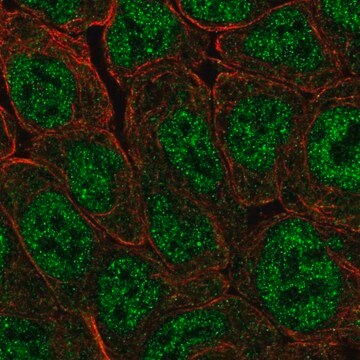
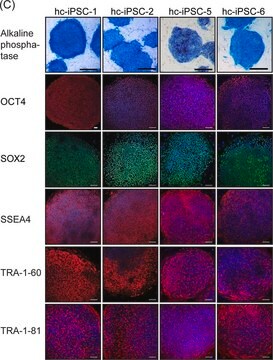
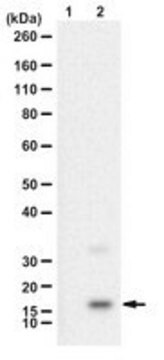
![Anti-OCT-4 [POU5F1] Antibody, clone 7F9.2, Alexa Fluor™ 488 conjugate clone 7F9.2, from mouse, ALEXA FLUOR™ 488](/deepweb/assets/sigmaaldrich/product/images/405/633/324511fc-ecc5-4c49-9d9d-8cf25ab28d40/640/324511fc-ecc5-4c49-9d9d-8cf25ab28d40.jpg)
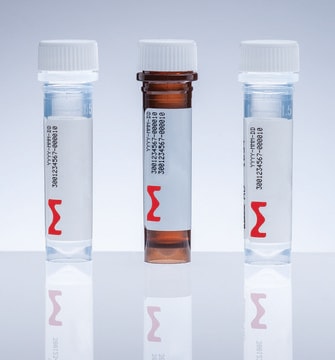
![Anticorps anti-OCT-4 [POU5F1], clone 7F9.2 clone 7F9.2, from mouse](/deepweb/assets/sigmaaldrich/product/images/307/874/7354f72d-80ee-40a5-b7fa-0590fe6784cc/640/7354f72d-80ee-40a5-b7fa-0590fe6784cc.jpg)
